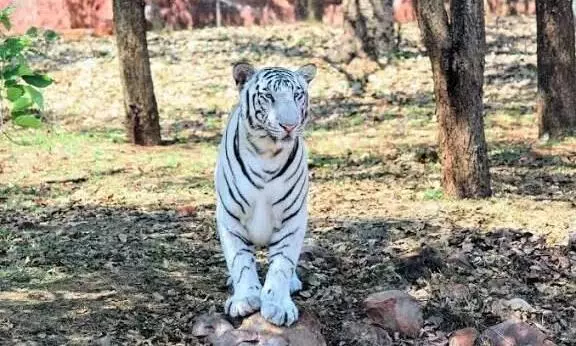
A trail of deaths casts a shadow on Tirupati zoo
Sameer, the beloved white tiger, is the latest to join a growing list of animal casualties

The Sri Venkateswara Zoological Park in Tirupati is facing a deepening crisis. Over the past year, a series of deaths—mostly of big cats, due to old age and illness—has cast a long shadow over the park. The latest loss is that of Sameer, the iconic white tiger who passed away on Sunday (October 19), ending a 14-year presence that had become synonymous with the zoo itself.
Sameer was brought to Tirupati from Hyderabad’s Nehru Zoological Park in 2010 when he was just five years old. Since then, he had captivated countless visitors with his majestic appearance and gentle demeanour. At 19 years of age, the ageing tiger succumbed to chronic illness and kidney failure, zoo officials confirmed. His death, though anticipated, has left the staff and regular visitors deeply saddened.
Over the past year, Sameer had quietly disappeared from public view. Visitors unfamiliar with his condition were puzzled by his absence, especially as he continued to feature prominently on the zoo’s website and promotional materials. Officials later revealed that due to age-related immobility, he had been moved to a secluded night shelter, where he remained under constant veterinary care. Unable to eat solid food, he was sustained on a liquid diet in his final months.
Also read: How Hyderabad Tiger Conservation Society built the human-leopard coexistence model
His condition had deteriorated to the point where intensive care was the only option. Following his death, a post-mortem conducted by experts from Sri Venkateswara Veterinary University confirmed nephrosis and age-related complications as the primary causes. His last rites were performed in accordance with protocol.
Three lions and a jaguar
Sameer’s passing is not an isolated incident. In August, the zoo lost a 23-year-old lioness named Sindhu, who had been battling illness. Brought in as a cub in 2002, she had long been one of the park’s key attractions. Prior to that, a lion named Vikram, aged 11, also died due to health complications.
The pattern is alarming. In December 2023, a lioness named Sita died at 23, and shortly after that, another male, Anurag, also passed away. In March 2024, a seven-year-old lioness died from pelvic tumours and internal injuries, despite undergoing surgery. She had refused both food and water in her final days.
In each case, the causes pointed to either ageing or chronic ailments—conditions often hard to manage despite consistent veterinary supervision. Zoo officials have attributed the frequency of these deaths to the advanced age of many animals relocated from other parks, especially Hyderabad’s Nehru Zoological Park.
Also read: As tiger mating season ends, safaris resume in Telangana reserves after three months
Among the most distressing incidents was the death of a 15-year-old jaguar named Kusa in 2023. Also brought from Hyderabad, Kusa was found dead in his enclosure with his head trapped between the branches of a tree. The unusual circumstances surrounding his death led to speculation, though officials stated it was accidental. His sudden end, after 15 years in the same space, had already left the staff shaken. Sameer’s demise now adds to the collective grief.
Deaths raise questions
The zoo, known for its conservation efforts and commitment to animal welfare, finds itself under emotional and operational strain. Many of its most recognised animals, once symbols of its success, are ageing. The recurring loss of these long-time residents raises questions about succession planning, medical readiness, and long-term care for geriatric wildlife in captivity.
Yet for the staff at SV Zoo Park, the emotional toll may be even heavier than the operational one. These animals, particularly those like Sameer who lived there for more than a decade, were not just attractions but companions in a shared mission of preservation and education.
Also read: White tigers, African lions: Hyderabad’s Nehru Zoological Park gets 309 rare species
As the zoo prepares to move forward, there is a growing need to invest in better geriatric care, improve habitat safety, and renew public communication. While death is inevitable in any zoological setting, the frequency and nature of recent losses demand deeper introspection—and perhaps a renewed commitment to the animals who remain.
(This article was originally published in The Federal Andhra Pradesh.)

